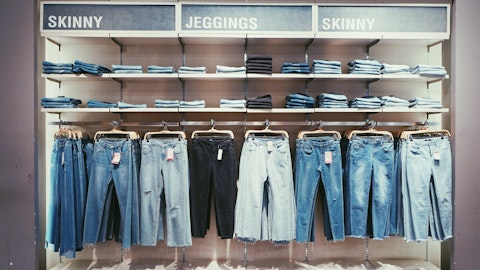David Swartz: Okay, thanks a lot.
Operator: Our next question comes to the line of Paul Kearney with Barclays.
Paul Kearney: Good morning. Thanks for taking my questions. On the brand marketing opportunities and investments you’re making. Can you go over what you’re doing differently today and where the marketing investments are concentrated and kind of the timing of those through the year? Thanks.
Stephen Bratspies: Sure. As you said, we increased our investment pretty significantly in the first quarter, and this has been a build over the last couple of years. One of the things that we’ve been focused on for a while now is strengthening our brands. And I think these brands have been underinvested in for a long period of time. And if you want to be a consumer centric company, you want to be a brand driven company, you want to be an innovation driven company. You have to invest and have to continue to lean in to your brands. The bulk of our advertising in the near term has been around and is going to continue to be around innovation. It leveraged the brand, but talk about the news and the news, last year was really around originals.
This year it’s around and by Maidenform. It’s the next stage of originals, which is super soft on the Champion side. It’s going to continue to talk about the brand and our positioning and how you know what that brand represents and really leaning in when we have our new fall winter line that’s coming as we go forward. And along with that in the back half, we’ll have Valley Breeze. So when you think about our advertising, you think about our media, think about it as leaning in behind branded innovation. And I think that’s the best way for us to talk about. The mix over time is going to continue to change, and depending upon the brand. So Haines will go to market differently than Champion will go to market. It’ll show up in different channels, whether that linear TV or that more direct to consumer channels.
And what gives me confidence is we’re starting to see the results of that. So take M Maidenform for example, when we started to really lean into that on the first part of this year, we saw POS jump 18% in that business. So we’ve got confidence that our messaging is right. Our approach is right. And we’re going to continue to make those investments over time. Back to some of the things we talked about earlier, our cost position and the way we continue to take costs out, of course, margin improvement, the SG&A focus enables us to fund those investments. And we’re going to continue to find that right balance.
Paul Kearney: Thank you.
Operator: Our next question comes from the line of Hale Holden with Barclays.
Hale Holden: Good morning. The last couple of quarters we’ve talked about declines in the U.S. Innerwear kind of industry, not necessarily your segment, but the whole sort of sales opportunity set. And was wondering, it sounds like you’ve seen that stabilize this quarter and in the next quarter. And maybe if you’d give us some dynamics about what you’re seeing in the segment.
Stephen Bratspies: Yes, I think when you think about the Innerwear segment, I think you have to think more broadly about the consumer environment and where it is. Overall, consumer demand remains challenging for apparel across the board in the U.S., Europe, Australia. We’ve been seeing those headwinds for several quarters, whether it’s interest rate impact, inflation. Consumers are definitely seeking value. We can see their activity of shopping events. And you definitely see that in the POS. When we look at the category from a long term perspective, I’ve got a ton of confidence that it’s going to rebound to historical levels, which is 1% plus growth. You’ve seen that go back to 08, 09, when all the challenges in the market right there, the categories impacted and then it rebounded.
We expect that’s going to happen over time. If you look at the last three years, on average, the category performed at historical rates. It’s just been incredibly disruptive. 2001, I hate to go back that far, was such a massive growth, 24%, 25%. And then, it’s been challenged ever since. But we expect that to moderate over time. We’re starting to see some stability over time. And we got a lot of confidence this category will perform to its long-term run rate as we go forward.
Hale Holden: Great. Thank you very much.
Operator: Our next question comes from the line of William Reuter with Bank of America.
William Reuter: Good morning. For the sales decreases of Champion, I was wondering if you could talk a little bit about what channels those decreases in, whether those were kind of specialty channels, whether they were off price channels, mass versus department stores. Where did you see the biggest declines in your sales into?
Stephen Bratspies: Yes, thanks for the question. When you think about it, it really varies by geography in terms of over performing. In the U.S. it’s really kind of generally across most channels or all channels. And that has a lot to do with cleaning up of inventory that’s been out there. And I think we’ve finally repositioned ourselves to a place where the channels are cleaner and we can prepare to move forward. And as I mentioned earlier, we’re excited about the fall winter line that’s coming and think that that’s going to help start to rebuild the business as we go forward. In Europe, wholesale has been has been challenging and the customers are just being conservative with they’ve been in inventory challenges in the past.
I think there are challenges going forward. When we look at Asia, Asia’s performing pretty well. Japan’s up, China’s up. We’re seeing opportunities there to continue to grow. And those have those markets have rebounded from where they’ve been the last couple of years. So I think it’s a mix by geography. But I think going forward, we’re well positioned across all the different channels. If you look at the U.S., our e-commerce business was up 12% in the first quarter. So we’re starting to build some momentum there. And more importantly, the programming that we have now is channel specific. And I think that’s what has been missing in the past. We weren’t we don’t differentiate it enough by channel. We weren’t segmented enough by channel and by product.


